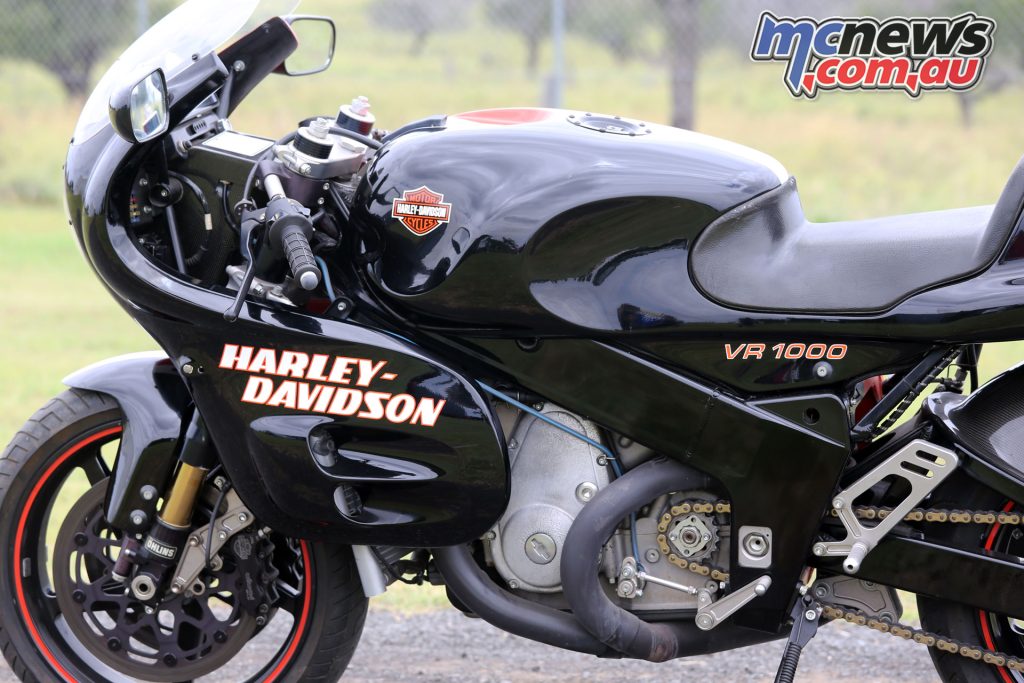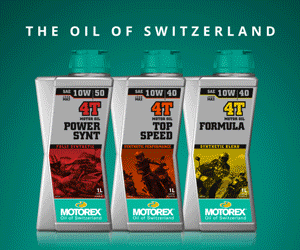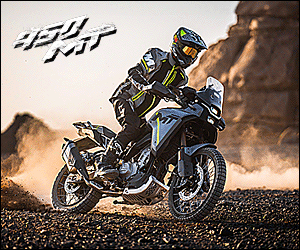Harley-Davidson VR1000
With Ian Falloon
Back in the early 1990s Superbike racing was in its infancy and twins enjoyed a huge weight and capacity advantage over fours. Ducati made the most of these regulations, dominating World Superbike racing between 1990 and 1992, and Harley saw an opportunity to do the same in AMA racing.

Due to a strong Yen making Japanese motorcycles very expensive, Harley’s sales were extremely buoyant in the late 1980s and early 1990s, breaking the 100,000 barrier for the first time in 1994. Amidst this economic prosperity Harley-Davidson decided to build their first ever purpose-built from the ground up pure racing motorcycle.
Every other Harley racer had been a modified production machine and this was also their first road racer since Gary Scott road a factory-entered XR750 amidst a horde of Japanese two-strokes at Laguna Seca in 1973. And as the VR1000 needed to be homologated for AMA racing, during 1994 Harley built 50 examples with lights and a number plate.

The AMA rule book stated the bikes should be “as sold for normal highway use,” but there was no way the VR1000 would pass strict EPA noise and emission regulations so they were homologated in Poland. As a result none could actually be legally ridden in America (or Australia for that matter).
The original VR1000 concept started in 1988 between H-D and Roush Engineering. Jack Roush was a Detroit-based consultant with car racing ties and designed the four-valve cylinder heads. Rouch employee Steve Scheibe was subsequently hired by Harley to manage the racing program. It was not until late 1993 that the first racer turned a wheel in anger in competition.

Powering the VR1000 was an engine in total contrast to the usual Harley V-twin. With a bore and stroke of 98 x 66 mm, the 60-degree V-twin featured plain bearings, fuel injection, liquid-cooling, double overhead camshafts, and a racing style dry clutch.
Taking a leaf from Ducati’s book, the EFI was by Weber Marelli, and with slightly lower compression than the racer (10.8:1 versus 12:1) and softer cams, the power was a claimed 135 horsepower at 10,000 rpm. Considering the most powerful production twin available in 1994 was the 131 horsepower Ducati 916 SP the VR1000’s power was ballpark but a five-speed gearbox hampered power delivery when six speeds were the norm.

The VR1000’s chassis was equally ground breaking for Harley, the aluminium twin spar frame designed by Oregon mountain-bike maker Mike Etough. Every component was state-of-the-art for 1994, including an upside down 46mm Öhlins front fork with titanium-coated stanchions, NASCAR-inspired Penske rear shock, Wilwood six-pot brake calipers, and carbon-fibre bodywork.
Detail touches included exquisite Bimota-like machine from billet footpeg brackets and levers, but the VR1000 remained an enigma, afflicted with awkward styling and a weird black/orange paint scheme. Rolling on a short 1410 mm wheelbase, and weighing a claimed 177 kg dry, every test praised the VR1000’s handling, and with a top speed around 270 km/h, at the time it was the fastest street-legal American made motorcycle.

Initial impressions were promising. In its first race at Daytona in 1994, DuHamel started the VR 68th on the grid and steadily moved up to 20th. When the counter-balancer came apart on lap 22, the machine had lasted more than 78 miles — 16 miles more than it’d need in the usual 62-mile Nationals.
Even more impressive, Duhamel had run laps in the 1-minute, 54-second range, not far off the pace of the leaders. Unfortunately the VR1000 project went pear shaped after 1994. Despite the long gestation period, the VR1000 race bike was fraught with failure and generally underperformed.
Despite predictions that the engine should make 165 horsepower this never eventuated. Although ridden by some of the best racers of the day, including Miguel Duhamel, Doug Chandler, Chris Carr, Pascal Picotte, Tom Wilson and Scott Russell, the VR1000 never won a race.

Bright spots included Duhamel leading at Mid-Ohio, finishing fourth at Brainerd and Carr taking pole at Pomona. More power for 1996 allowed Carr to finish 10th at Daytona.
By 1995 the race shop employed only five technicians and the program was run on a shoestring out of a building away from the factory in an industrial park. In the wake of poor results rumours circulated of management disputes that would seal the VR1000’s fate. Milwaukee had never been comfortable with the concept of purebred competition machines and the VR1000 simply reinforced this predilection.

As had happened fifty years earlier a battle loomed between the factions for economic rationale and the sporting protagonists. Economic rationalists perceived expensive factory racing as a large expense versus a small return, while the sporting enthusiasts argued racing paid dividends in public relations and publicity, also winning hearts and minds.
While the Superbike racing program continued on a small scale for a few more years, without a street-legal production counterpart the racing was meaningless. Only 50 homologated street bikes were built but following the VR1000’s demise, Harley applied much of what it learned to the 2002 VRSCA V-Rod.

The VR1000 died with a whimper but more than thirty years on many now view Harley’s Superbike foray as a missed opportunity.
1994 Harley-Davidson VR1000 Specifications
| 1994 Harley-Davidson VR1000 Specifications | |
| Engine | Four stroke, 60 degrees V-Twin, DOHC, 4 valves per cylinder. |
| Capacity | 996 cc |
| Bore x Stroke | 98 x 66 mm |
| Compression Ratio | 11.6:1 |
| Induction | Weber EFI |
| Ignition / Starting | Electronic / electric |
| Max Power | 135 hp @ 10000 rpm |
| Clutch | Dry Multi-disc |
| Transmission / Drive | Five-Speed / chain |
| Frame: | Aluminium Twin Spar parameter |
| Front Suspension | Öhlins fork |
| Rear Suspension | Penske Shock |
| Front Brakes | Dual Wilwood discs |
| Rear Brakes | Wilwood disc |
| Tyres | 120/70 ZR17, 170/70 ZR17 |
| Wheelbase | 1410 mm |
| Wet-Weight | 177 kg |
| Fuel Capacity | 17 Litres |























